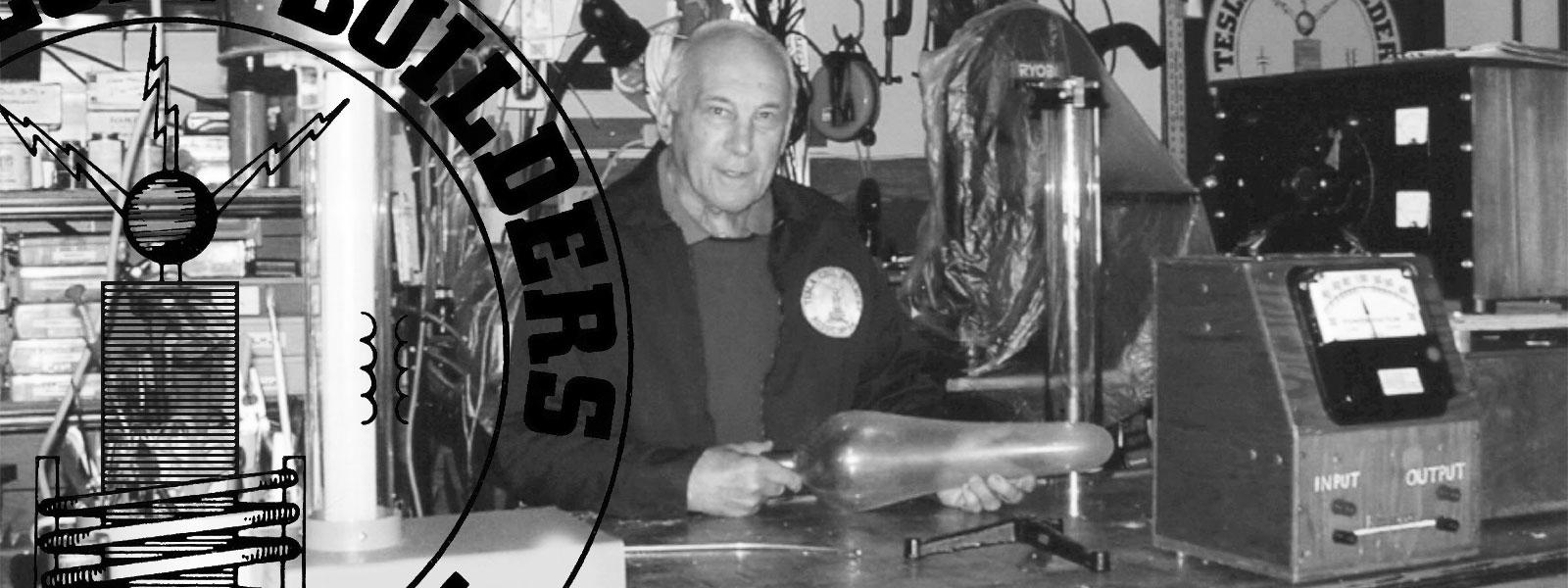TCBA Volume 8 - Issue 1
Page 1 of 18
Cover
The lady on the cover of this issue is not dancing to music but is responding to electric shocks coming from the radio. Although this novel approach does include a safety circuit, connecting one's self to an old radio is not recommended. Those old 1930's sets were not properly insulated from the 60 Hz line. There are other experiments in the accompanying article, however, that do not involve human contact. Anyone with an old radio might want to duplicate them.
Elsewhere in this issue, you will find a home constructed shocking coil project that will fulfill anyone's desire for tickling their friends. Unlike the radio-adapted system shown on the cover, this device runs on a 6-volt battery and is relatively safe (unless you need bypass surgery).
Frankenstein's Lab
TCBA member Anthony DeAngelis had a key hand in developing the high voltage apparatus for the Boston Museum of Science “Frankenstein's Lab” show. The 25-minute dramatic presentation recreates the most famous scenes from the original Boris Karloff movie, FRANKENSTEIN (see Volume 6, #4). Several scientific devices including large Tesla coils as well as chemical special effects were used to provide audiences with entertainment. If you have never visited the Boston Museum of Science, you are urged to schedule a visit in your future traveling plans. The Museum offers many facets of science including the original Van de Graaff generator that made high voltage nuclear physics history at MIT during the 1930's. Space limitations require running the generator at only 2.5 million volts. What a sight it must have been back in the 1930's when the machine was wound up to 7 million. Even so, the snappy 20-25' discharges are guaranteed to keep you from falling asleep.
From Van de Graaff Generators to Laser Beams
The INDIANAPOLIS STAR for October 16 carried a report hearalding the students of electrical engineering at Purdue University. One photo shows a young man holding a wand being struck by long discharges. Under the photo was the caption, “From Van de Graaff generators in the '30's to laser beams in the '80's, Purdue has been in the forefront of engineering research.” Trouble is, the device producing the long sparks was a Tesla coil, not a Van de Graaff. The Tesla coil appeared to be identical in both design and size to the unit built by the U. of California students in the 1920's (see Volume 1, #1). (Tip from Doc Taylor).
Dedication: Two Unknowns
SAM RUBEN, whose many patents included the alkaline battery, died last July at the age of 88. He was better known in the scientific and business world than by the general public. Although he had no formal education beyond high school, Ruben received numerous academic honors as well as formal recognition from the engineering (electro-chemical) community.
Among Ruben's invaluable contributions was the mercuric-oxide dry cell battery used in electronic watches, earth satellites, heart pacemakers, and distress-signal transmitters used in airplanes. He contributed to the development of radio in the 1920's by creating a solid-state rectifier. This enabled radio circuits to be designed for use on house current. Another invention that made radio listening more pleasurable was his “7 second tube.” This reduced the warm-up time in radio listening. Yet another Ruben contribution to radio was a dry electrolytic capacitor. This device made it possible to radically reduce the size and cost of radios.
During WW II, he came up with the sealed mercury battery that led to many advances in military technology. Ruben voluntarily turned over all patents to the Government during the war and also cancelled his royalty agreements.
In addition to his 300 patents, Ruben served as a professor of physics at the college and University level.
And all this from a man with only a high school education.
EMILE BACHELET was born in Paris in 1863. He came to the U.S. in 1880 and first settled in Boston. During his years there, Bachelet served as an electrical technician at Boston Tech.
Emile later became the chief electrician for the State of Washington. It was there that he developed an interest in electromagnetics. Batchelet noticed that the pain of an arthritic foot was relieved while working near the giant generators. In 1906, he opened the Bachelet Bracewell Laboratories in Mount Vernon, NY. It was at this laboratory where Bachelet began experimenting with magnetic levitation. A patent was issued for a Magnetically Levitated Railroad” (Maglev) in 1910. Newspapers described Emile's invention as the “Wonderful Flying Train.”
When Bachelet demonstrated his invention in London, Winston Churchill hailed it as “the most wonderful thing I've ever seen.” Recently, Senator Patrick Moynihan (D-NY), labeled Maglev a “revolutionary new mode of transportation....” Japan's “Bullet” train is a direct descendent of the original flying train. Emile Bachelet's scientific papers and inventions will soon be given display space at the Smithsonian Institution.
(Maglev trains are being planned for several locations in the U.S.)
